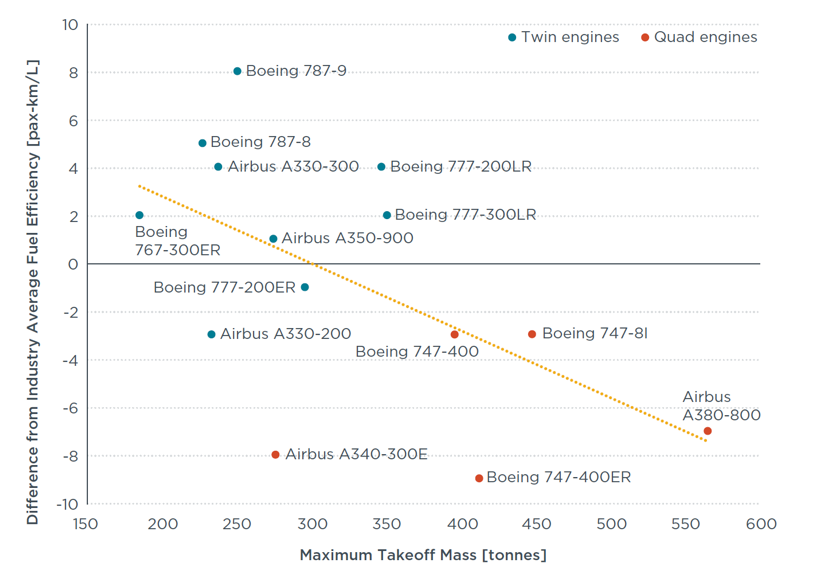International Civil Aviation Organization CO2 standard for new aircraft
Blog
Size matters for aircraft fuel efficiency. Just not in the way that you think.
In our recent transpacific airline ranking, we assessed and compared the fuel efficiency of the top 20 airlines operating flights between the U.S., East Asia, and Oceana. One interesting finding was that airlines that predominantly use the four-engine Boeing 747 and Airbus A380 aircraft – Asiana, Korean Air, and Qantas – had the lowest overall fuel efficiency on transpacific operations. The question is, why?
One might assume that the larger the plane, the more fuel-efficient it is per passenger due to economies of scale. But in the case of flights over the Pacific, conventional wisdom turns out to be wrong. Size matters, but not in the way you think.
Airlines that operate very large aircraft burn more fuel and release more carbon than their peers. There are two reasons for this, one related to the aircraft itself and the other to how they are used on transpacific flights. Aircraft with four engines, or “quads”, tend to be less fuel-efficient than twinjets due to inherent design factors such as a higher wing weight and a smaller engine fan diameter. Second, quad aircraft operated with relatively fewer passengers over the Pacific in 2016 compared to twinjets due to lower seating densities and passenger load factors.
Taken together, overall very large four-engine aircraft used on transpacific flights had 24% lower fuel efficiency per passenger than aircraft with two engines in 2016 (see figure).

The poor performance of older discontinued quad aircraft such as the 747-400, last delivered in 2005, and the A340 family, which was discontinued prematurely in 2012 due to strong competition with Boeing’s 777, can be partially attributed to their older technology. That’s not the case for Airbus superjumbo A380, which was touted as an engineering marvel when first flown and is still being manufactured today.
Airbus made a big bet on the superjumbo A380, which is half again as large as the Boeing 747 and certified to seat up to 853 passengers on two full decks. When it first entered into service in 2007, it was hailed as an aircraft perfectly designed for carrying passengers between large, congested hub airports. Boeing made a different bet, marketing aircraft like the B787 “Dreamliner” that would enable future travelers to fly direct even on long, “thin” international routes with relatively few passengers. In hindsight, that turned out to be the smarter move.
Today, it’s increasingly clear that the A380 is a dud from both a business and environmental perspective. Airbus has admitted that it will never recoup its $25 billion dollar investment in the A380 and, despite courting Chinese airlines, is increasingly reliant upon a single customer, Emirates, to keep the production line alive. Emirates recently agreed to purchase up to 36 new aircraft, which would extend A380 production out to 2027 or 2029, depending on whether an additional 16 options are exercised. However, the A380 is unlikely to pass the International Civil Aviation Organization’s aircraft CO2 standard, and, therefore, will not be able to be sold internationally after 2028 unless its fuel efficiency is improved. Thus, the purchase may revive Emirates’ previous demand that the A380 be refreshed through re-engining as an A380neo option, which Airbus has been slow to develop.
For years, Airbus tried to market the A380 as the “Gentle Green Giant,” touting the aircraft as one of the most fuel-efficient planes in production in 2007. Our transpacific study shows that this is no longer the case. For an aircraft of its size, the A380 carries relatively few passengers – typically on the order of 350 per transpacific flight, compared to 200 for the 787-9, despite having two and half times the floor space – and limited freight carriage. Instead, smaller twin engine widebodies like Boeing’s 787 and Airbus’s A350 are the way to go for fuel efficiency. The Boeing 787-9 in particular was the most fuel-efficient aircraft on 2016 transpacific flights at 39 passenger kilometers per liter of fuel, or 60% better than the A380.
There’s a reason airlines around the world are no longer buying very large aircraft like the 747 and A380. Previously, quad aircraft were necessary for extended transoceanic flights, as Extended Range Operation with Two-Engine Airplanes (ETOPs) for twinjets were insufficient. But today’s twinjet widebodies provide both the ETOPS range and belly freight capacity required to meet even the most demanding routes. Very large aircraft are no longer needed for transpacific flights (and burn a lot of fuel to boot).
The good news is that many airlines are purchasing fuel-efficient twinjets for use on international routes and mothballing their very large aircraft. We expect to see improvements as a result on future rankings. Watch this space.
